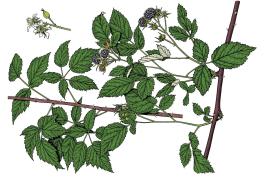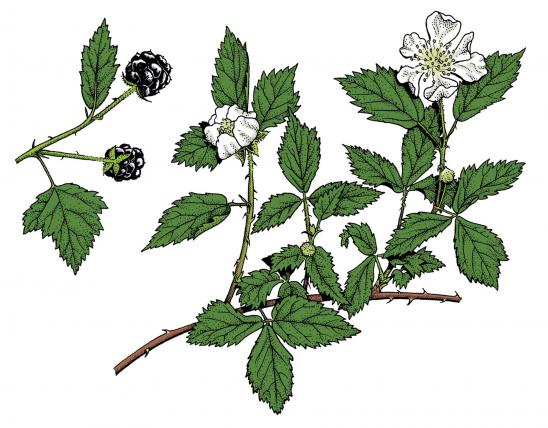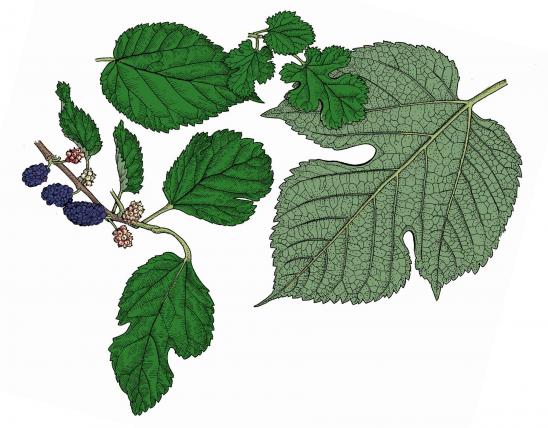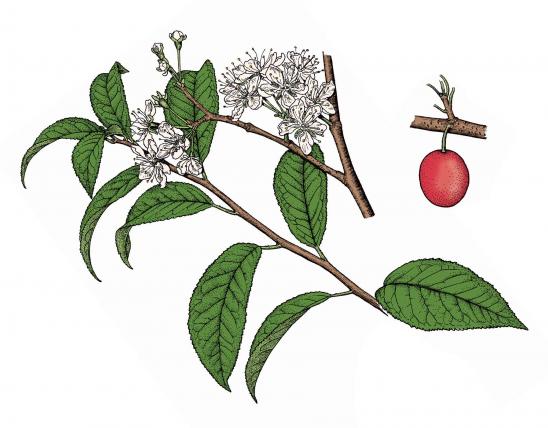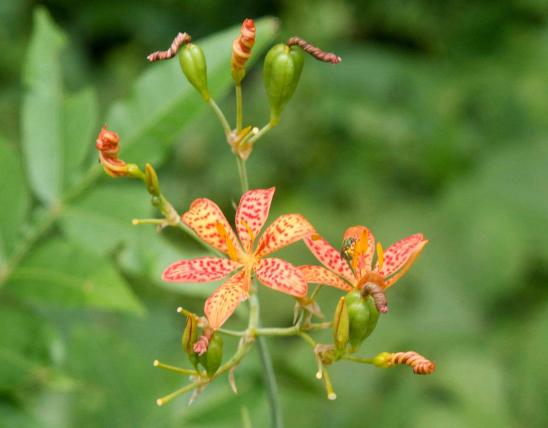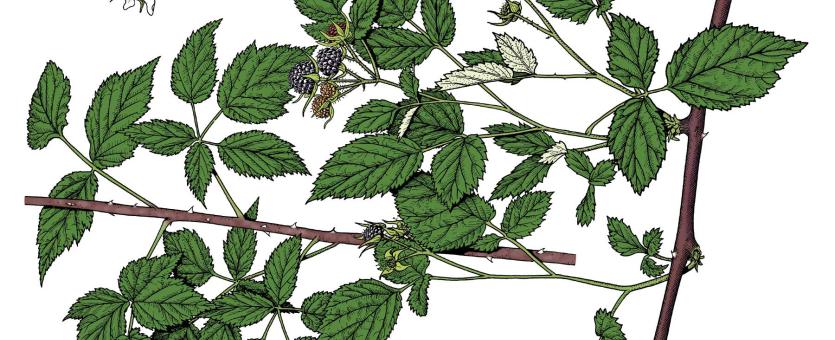
Black raspberries resemble blackberries, but when ripe, the fruits fall away as a caplike unit from the receptacle. Leaflets appear white underneath. The canes are whitish-coated when young; they arch down and take root at the tips. Native and scattered statewide.
Black raspberry is an arching shrub, the young canes reaching a height of 3–7 feet, but as the stems grow longer, they arch down and take root at the tips.
Leaves are alternate, compound with 3 or 5 leaflets; all leaflets broadly egg-shaped to lance-shaped; the end leaflet commonly 2¾–3¼ inches long, tapering to a narrow point, the margin sharply and unequally double-toothed; side leaflets smaller and narrower, more or less lobed; leaflets on flower canes smaller, perhaps 2½–3¼ inches long, 1½–2½ inches wide; upper surface on all leaflets dark green, slightly hairy; lower surface densely white with matted hairs; leaf stalk 2–2½ inches long, smooth and usually bearing short, stout, curved prickles.
Twigs are flexible and smooth, the first-year canes with a whitish coating that rubs off; they are bluish green in summer, turning purple (or rarely yellowish green) in winter; prickles are broad-based and recurved (bend backward).
The trunk-like older canes have a smooth bark, are reddish purple with a whitish coating, the prickles or thorns recurved and stout; the wood is soft, white, with a large pith.
Flowers April–June, in tight clusters of 3–7 flowers on the end of shoots; the flower stalks are hairy and bear stout-hooked prickles; flowers are ½–¾ inch across; petals 5, white, narrow, stamens numerous.
Fruits June–July, firm and compact, the center hollow and thimblelike, purplish black, aromatic, mostly globe-shaped with a flattened base, about ½ inch across, becoming detached as a unit from the receptacle; seeds are straw-colored, egg-shaped to crescent, the surface net-veined.
Similar species: Rubus is a large genus with about 30 species recorded in Missouri. Globally, there are some 1,350 species. Included in the genus are blackberries, raspberries, loganberries, dewberries, and brambles. The members of genus Rubus often interbreed and hybridize, and the canes often change their appearance between first and second growing seasons, making them a tricky group even for botanists to sort out.
The genus Rubus is so large and complex that botanists divide it into 5 subgenera and numerous “sections.” Black raspberry is in subgenus Idaeobatus, the raspberry subgenus, and compared to the subgenus including blackberries and dewberries, this group of plants is somewhat easier to sort out. Members of the raspberry subgenus share the following characteristics:
- Leaves on the first-year canes are pinnately or palmately compound, felty-hairy (white) on the undersides.
- The ripe fruits fall freely, intact, from the receptacle (carpel), looking like a little cap or bowl.
- The sepals are long-tapered to a threadlike tip.
In Missouri, 4 species in the raspberry subgenus have been recorded in the state. Black raspberry is by far the most common and widespread. The rest are less common. The red raspberry you are familiar with from the grocery store is included, but it apparently does not last long in nature, out of cultivation:
- Red raspberry (Rubus idaeus var. strigosus). Differs from our other raspberries with its erect to arching canes that do not root at the tips, and purplish-red fruits. Introduced, known only from historical specimens from Barry and Jackson counties, where a few plants appeared to be growing out of cultivation (one, for example, was a seedling growing along a logging road). This native American red raspberry originally occurred in the northeastern United States and adjacent Canada, but not in Missouri. Botanists debate whether our North American raspberry and the European red raspberry (R. idaeus var. idaeus) are the same or different species. Where they are regarded as separate species, American red raspberry is labeled R. strigosus and European red raspberry is R. idaeus. Most red raspberries cultivated in Missouri are domesticated versions of the European red raspberry.
- Japanese raspberry (Rubus parvifolius). The first-year canes are not whitish-coated; central leaflets on first-year canes are reverse-ovate (with the widest part toward the outer tip); the flower petals are pink or reddish; the ripe fruits are glossy red. Introduced, native to Asia and Australia; in Missouri, known only from Greene County, where it has been found near the Dickerson Park Zoo; the population has continued to expand locally. It typically grows on the edges of mesic upland forests, along roadsides, and in open disturbed areas. In Iowa, some introduced populations appear to be expanding and may invade native prairies and savannas.
- Wineberry (Rubus phoenicolasius). Introduced, native to Asia; uncommon and sporadic in southern Missouri; occurs in bottomland forests, disturbed openings of rich upland forests, and bases and ledges of bluffs, also along railroads and roadsides. Identify it by its slender, straight prickles and red to purple hairs, many of which are gland-tipped; flower petals are white to pale pink; sepals covered with reddish, gland-tipped hairs; fruits orangish red. In some states, it is considered an invasive nonnative, forming dense thickets that crowd out native plants.
Cane length: to 13 feet. Canes of young plants reach about 7 feet tall but then arch back to the ground and take root at the stem tips.
Scattered nearly statewide.
Habitat and Conservation
Occurs in mesic (rich/moist) upland forests, bottomland forests, bases and ledges of bluffs, banks of streams, upland prairies, loess hill prairies, and savannas; also in pastures, fencerows, ditches, railroads, and roadsides.
Many people cultivate (or encourage natural populations of) raspberries, blackberries, and related shrubs for their fruit.
Status
Native Missouri shrub. Valuable for human and wildlife food. Brambles like this plant provide important cover for wildlife. Increasing in popularity as a native plant for cultivation; cultivated varieties have been developed.
Human Connections
This is one of the many Rubus species that is cultivated as food for people, and several cultivated varieties have been developed. Also, this species has been used as a parent plant in creating raspberry hybrids. This species is heavily cultivated in Oregon. Fruits are eaten raw or made into juice, purées, wine, liqueur, pies, jams, jellies, and more.
Raspberries, blackberries, and other members of genus Rubus are very popular as edible landscaping plants. Many cultivated varieties and hybrids are available. They not only give us delicious fruits, but also provide benefits for wildlife: the flowers are excellent sources for pollinators, and the fruits are loved by songbirds and other animals.
Black raspberries and their relatives are nutritious and are a good source of vitamins C and K, manganese, fiber, and antioxidants, with a low glycemic index. Many people rank them as a “superfood,” since they’re high in nutrients, fiber, and antioxidants and low in carbohydrates and fat.
Raspberry and blackberry recipes abound, and it seems that people come up with new culinary uses for them each summer. The possibilities are limited only by your creativity!
- Raspberry and blackberry cobbler, pie, muffins, pancakes, juice, jam, and jelly are delicious.
- Raspberries can also be used in ice creams, sorbets, smoothies, cocktails, infused water, milkshakes, and fools (a dessert made with whipped cream).
- You can make a sweet/savory raspberry sauce to use as a glaze or relish for pork, salmon, or chicken (think of a fruity barbeque sauce or a chutney).
- Cheese and fruits are a famous combination. You can have raspberries with baked brie, on a cheese plate, or melted together on flatbread as fruit-and-cheese pizza.
- Sprinkle raspberries on a green salad with feta or goat cheese and some nuts, dressed with a raspberry vinaigrette.
- Toss raspberries on your hot or cold cereal.
- Use raspberries in gelatin salads and desserts.
- Raspberries can be mixed with at least two other kinds of berries (such as blueberries, blackberries, and strawberries) to produce a favorite pie and jam combo called “bumbleberry.”
No doubt much of the folklore referring to “blackberries” also applies to black raspberries, which superficially look very similar. Visit our common blackberry page for more fun human connections.
Ecosystem Connections
Brambles provide food and cover for many species of birds and small mammals. They have a very high value for wildlife.
Deer eat the fruit and browse the tender canes in spring and summer. Other mammals that eat black raspberry fruits or other plant parts include elk, foxes, bears, rabbits, raccoons, opossums, squirrels, mice, and chipmunks.
Much of the summer diet of wild turkeys is composed or raspberries and blackberries. The list of other birds that eat black raspberry fruits is long, including waxwings, tanagers, cardinals, grosbeaks, indigo buntings, crows, blue jays, sparrows, finches, towhees, blackbirds, grackles, orioles, thrashers, catbirds, mockingbirds, titmice, grouse, quail, pheasant, prairie-chicken, bluebirds, robins, thrushes, and more.
Birds and mammals that eat black raspberry fruits typically poop out the still-viable seeds; in this way, they serve as a dispersal mechanism for the plant, so that the offspring raspberry bushes germinate in new locations away from the parent colony. Having offspring live in a variety of new locations increases the odds that at least some of them will survive and reproduce, continuing the genetic line, even if the parent colony is wiped out.
Many small animals, including rabbits, mice, and birds, find much-needed shelter within the maze of prickly stems in a briar patch. Several types of birds may nest in these thickets.
The flowers of black raspberry and its relatives, much like those of wild rose or strawberry, are a favorite nectar source for many pollinator insects, including a very wide variety of native bees in several families. Butterflies, beetles, flies, wasps, ants, and other insects are attracted to the pollen and nectar.
A bewildering variety of insects consume the leaves, sap, stalks, or other plant parts of raspberry and blackberry bushes. Insects that chew the leaves include various species of leaf beetles, grasshoppers and katydids, and several types of moth and butterfly caterpillars. Insects that suck the sap include various species of plant bugs, stink bugs, aphids, leafhoppers, and treehoppers. Insects that eat the canes include certain types of metallic wood-boring beetles and longhorned beetles.
With all the pollinating, leaf-eating, and sap-sucking insects they attract, a colony of black raspberry bushes becomes a kind of mini-habitat. Mantids, ambush bugs, robber flies, crab spiders, and other insectivores hunt the herbivore insects. All these protein-rich insects are attractive to birds, which are especially hungry for insects during nesting season.

